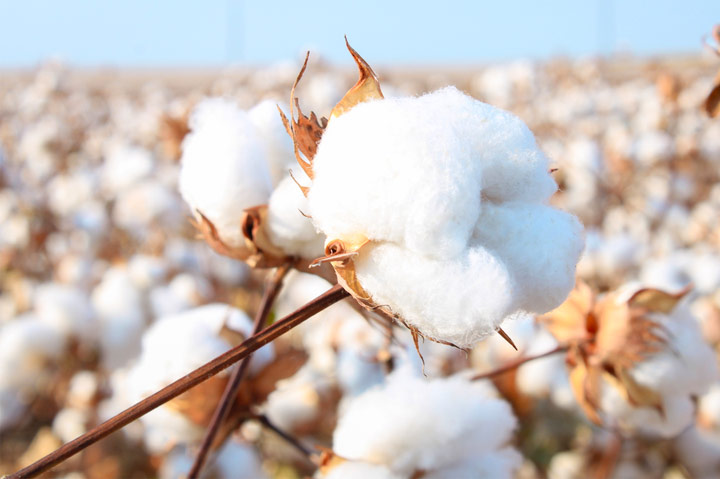Sustainability February 15, 2022
Report: Not All Organic Cotton Is Actually Organic
There’s significantly more organic cotton coming out of countries like India than there are organic seeds in circulation. Something doesn’t add up, according to an investigation by The New York Times.
Demand for organic cotton has been growing. The only problem? A significant portion of the so-called “organic cotton” being used today is not actually organic, according to an investigation by The New York Times.

Proponents say that organic farming practices, which don’t rely on chemical pesticides, synthetic fertilizers or genetically engineered ingredients, keep millions of pounds of chemicals out of the environment, create healthier working conditions for agricultural workers and reduce climate change. As awareness of sustainability increases, so too has interest in organic fabrics.
Organic cotton production in India has more than doubled in the last four years, according to annual tallies by Textile Exchange, an organization created to promote sustainability. In 2021, 124,000 metric tons of organic cotton were produced in India, Textile Exchange reports. But industry insiders told The New York Times that figure is an impossibility based on the limited quantity of organic seed in circulation.
Crispin Argento estimates that between one-half and four-fifths of what is being sold as organic cotton from India is not genuine, telling the Times that the supply chain from the country is a game of “smoke and mirrors.” Argento is the founder and managing director of the Sourcery, a small consulting firm that helps brands source organic cotton.
50-80% of what's being sold as organic cotton from India is fraudulent.
— Fair World Project (@fairworldprj) February 15, 2022
The problems? A shortage of non-GMO seeds & too many brands who are more interested in marketing "organic" than paying the true cost of production.https://t.co/9V37j6hmFh
In a LinkedIn post after the Times article was published, Argento elaborated that though his company emphatically supports organic cotton as a philosophy, the system certifying the textile is deeply flawed and outdated. It “needs to be rebuilt from the ground up where farmers, true transparency and measurable verified impact are the centerpiece of organic cotton’s future – not a piece of paper,” he noted.
Currently, the Global Organic Textile Standard (GOTS) is considered the gold standard for certifying whether cotton is organic. According to the Times: “In India as well as other cotton-producing countries, GOTS and Textile Exchange certification starts at the gin, where the cotton fiber is separated from the seed. A paper transaction certificate is issued each time the cotton is sold along the supply chain: from the gin to a certified spinner, where the fibers become thread; to a certified mill, where the threads become fabric; and on until it lands in the form of a shirt or sheet set in a store near you.”
One of the main issues with this system, however, is that neither certification process performs inspections themselves, relying instead on international inspection businesses, like OneCert and EcoCert. The inspection businesses – paid by farmers, spinners and other entities they’re tasked with policing – only inspect and verify facilities once a year, producing a paper certificate that’s sent to GOTS and Textile Exchange.
As the Times explains: “Insiders call this system ‘trading paper,’ and say that at each step, there is little to stop a facility from selling a pile of conventional cotton as organic, then changing a paper transaction certificate to match the larger volume.”
The issue is not limited to India, and questions have been raised about organic cotton from China and Turkey – two other big players in the organic cotton supply – according to the Times.
Certification companies are aware of the potential for fraud. In October 2020, for example, GOTS announced that it had uncovered a scheme to create fake transaction certificates and websites. It banned 11 companies – representing at least 20,000 tons of organic cotton fiber – from its system.
Critic of the status quo, like Argento, however, believe that organic cotton can be so much more than “just a certificate, sales point on a product or a logo on a hang tag.” He advocates investing in the farmers themselves, rather than middlemen, to make a meaningful and measurable impact.
Eric Henry, president of TS Designs, a North Carolina-based apparel decorator that follows a “dirt to shirt” model and shares supply chain info via a QR code printed on shirt tags, agrees. “I believe when you look at sustainability as just another checkbox, this is what you get,” he wrote on LinkedIn in response to the Times article. “We’ve struggled with growing organic cotton in the Carolinas, but we’ve proven it can be done – we just can’t do it alone. We need apparel brands that see this value in organic cotton and are willing to make the long-term investment to make it a reality.”

Promo for the Planet is your destination for the latest news, biggest trends and best ideas to help build a more sustainable and socially-responsible industry.
